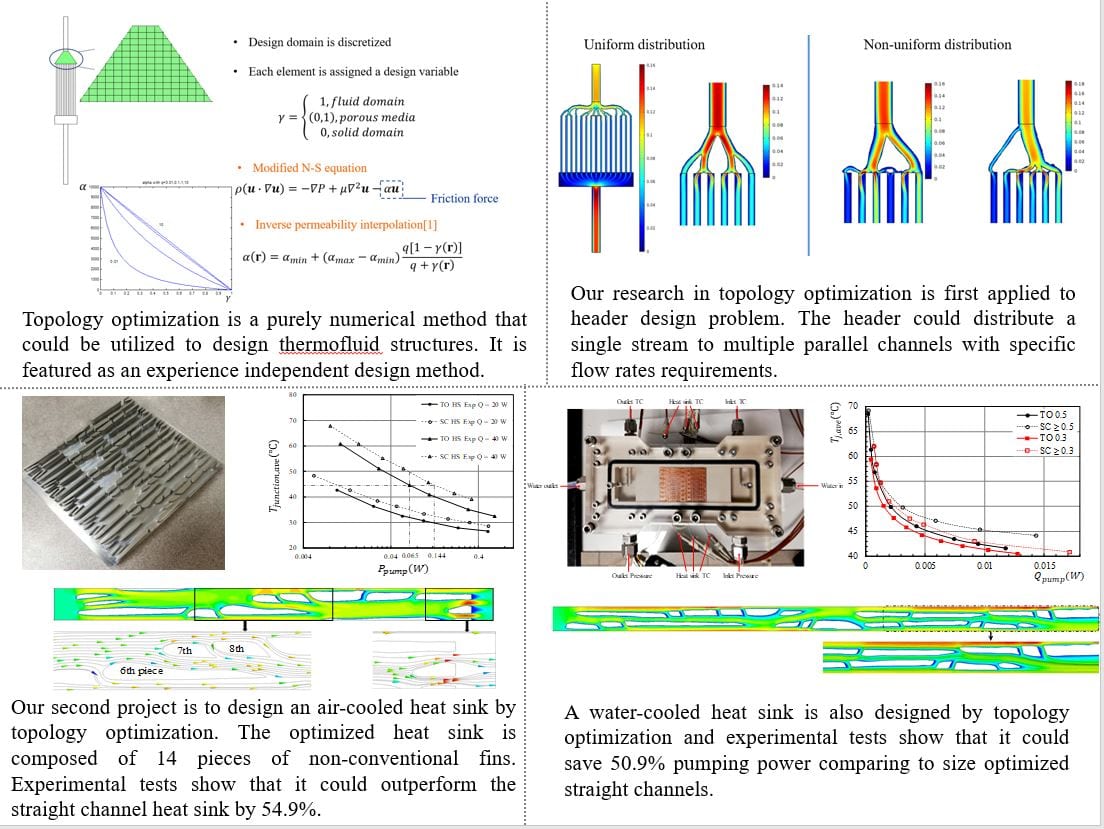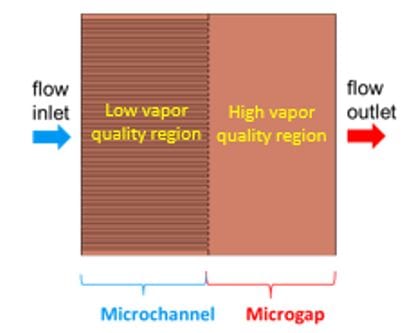Single Phase Transport in Microchannels
|
Although a significant number of studies have been devoted to the investigation of the single phase transport in microchannels, there has been little agreement among different studies. For instance, there is no general agreement as to the applicability of conventional theories in predicting single-phase heat transfer performance in microchannels. The primary goal of this work is to perform careful and systematic experimental investigations into single-phase flow and heat transport in microchannel heat sinks. Comparisons with conventional theory and existing correlations are also made to allow for a critical assessment of their applicability. |
Two Phase Transport in Microchannels
|
Flow boiling in microchannels has attracted a lot of attention in recent years due to its ability to dissipate significantly higher heat fluxes by utilising the latent heat of vaporisation while requiring smaller rates of coolant flow than its single-phase counterpart. Another advantage of the convective boiling process is the greater temperature uniformity across the microchannel heat sinks as the phase-change process takes place at the fluid saturation temperature. In spite of these appealing attributes, the mechanism of convective flow boiling in microchannels is still not well understood and this has impeded their implementation in practical applications. The objective of the present work is to conduct careful and systematic experimental investigation of flow boiling heat transfer and pressure drop in microchannels over a range of channel dimensions, heat fluxes, mass fluxes and fluids. Boiling heat transfer and two-phase pressure drop correlations developed for conventional channels will be critically appraised for their applicability to the prediction of flow boiling behavior in microchannels. In addition, high speed flow visualization will be conducted to explore flow boiling flow and develop flow maps. The coupling of high-speed boiling visualization and temperature and pressure data will allow a better understanding of the different flow boiling mechanisms. Examples of flow boiling are recorded via high-speed camera and are shown in the video clips below. |
|
Video clip courtesy of Tamanna Alam
Copyright Micro Thermal Systems Group |
Video clip courtesy of Tamanna Alam
Copyright Micro Thermal Systems Group |
|
Experiment conditions Observation |
Experiment conditions Observation |
Topology Optimization of Heat Sink Design
Improving slow boiling stability of microchannel heat sinks
|
Hybrid microchannel-microgap and periodic stepped fin geometric configurations
|
The objective of this research project is to stabilize microchannel flow boiling operation by means of implementing geometric configurations that reduce vapor backflow.
In the first part of this project, a hybrid microchannel-microgap heat sink is developed which consists of a straight microchannel array in the upstream region of the heat sink followed by a microgap channel in the downstream region. The microchannel section operates in the low vapor quality upstream region while the microgap channel operates in the high vapor quality downstream region such that each section operates in the region where it has been demonstrated to offer better two-phase heat transfer performance in prior research. Vapor backflow is mitigated as the increasing flow cross-section area towards the microgap channel promotes forward motion of vapor bubbles and slugs due to the difference in surface tension forces in the upstream and downstream regions. In the second part of the project, a periodic stepped fin microchannel heat sink is developed to stabilize flow boiling by facilitating span-wise vapor bubble expansion at different locations along the flow to limit rapid bi-directional vapor bubble expansion. This heat sink design involves the removal of sections of straight microchannel fins to half their full fin height to create interconnected transverse channels in the upper flow region. Such a configuration provides room to accommodate expanding vapor slugs in the transverse interconnected sections. Unlike other expanding microchannel flow configurations, the available wetted surface area of the periodic stepped fin microchannel is not severely compromised. |
Enhanced Pool Boiling Performance with Engineered Fin and Porous Structures
Vortex-Enhanced Air-Cool Data Center
| Data center suffers the severe hot recirculation (hot exhausted air re-entries the server) historically and it has elevated the cooling expenditure due to a lower cold air set point.
A novel hot aisle design was proposed to address such an issue. A vortex flow forms at hot aisle which prevents the hot recirculation effectively in the new design. It has shown a 3oC server inlet air temperature reduction through the numerical CFD study.
Potential energy saving is possible as it allows a lower fan speed or a higher cold air temperature set point. The results obtained from CFD model are going to be validated through a scale-model as well as the on-site test. |
Hot Spot Mitigation Strategies
|
Though microchannel heat sinks are highly effective cooling devices for electronic components, significant temperature variations across the chip still persist since the heat transfer performance deteriorates in the flow direction in microchannels as the boundary layers thicken and the coolant heats up. The temperature non-uniformities are compounded by the fact that different integrated circuit (IC) components can generate significantly different amounts of heat. These temperature gradients across the chip and so-called localized “hot spots” can compromise the reliability of ICs and result in early failures. Therefore, it is desirable to further enhance the heat transfer performance of a microchannel heat sink, both globally and locally. One of the proposed strategies involves the creation of recess(es) in the lid of a microchannel heat sink for modulating the flow resulting in heat transfer enhancement. A conventional microchannel heat sink involves fluid flowing straight through from the entrance to the exit of the channel. When a recess is introduced into the lid, the fluid relaxes into this expansion. For a given fixed pressure drop across the heat sink, the presence of the recess |
Enhanced Air Side Thermal Transport via Novel Fin Structures
|
Thermal management is a must in many applications.
Air is still a coolant of preference.
The conventional heat sink & heat exchanger designs cannot maintain safe operating temperatures for electronics or cope with the heat dissipation loads. The newly designedCross-connected alternating converging-diverging channel can :
|
Functionalized Aerogel for Treatment of Indoor Moisture and Air Contaminants (FATIMAC)
|
A significant fraction of the total energy consumed by air conditioners in warm and humid climates (e.g. Singapore) is utilized for moisture removal by condensation on evaporator tubes. This project aims to reduce this energy consumption by using desiccant coated fin-tube heat exchanger that removes moisture from the air in a nearly isothermal process. This reduces the latent heat load on the evaporator and reduces the temperature of heat required to regenerate the desiccant, thereby enabling the utilization of condenser heat. Estimated energy savings is > 20%. |
Other ongoing projects
|
|
Facilities and Equipment
| 3-Axis Measuring Microscope Model: Mitutoyo MF-B1010C
The Mitutoyo MF series Measuring Microscope is multi-purpose measuring microscope for inspection use. It can perform precision measurement of work piece dimensions, contours and surface features. Microfluidics Particle Image Velocimetry
On loan from Fluid Mechanics groupMicrofluidics PIV is a new and innovative technique for quantifying flows in microstructures, MEMS, biomedical flows, Lab-on-a-chip etc. It helps researchers to obtain the flow motion and velocity distribution in micro scale channels by allowing detailed and accurate microflow measurements in microchannels and similar devices. High-Speed Camera The FASTCAM SA5 is a powerful engineering tool for use in research and development, design, production, and quality control, and in numerous fields. The system features superior basic performance with mega pixel resolution, an ultra-sensitive image sensor capable of clear recording in low light, and an ultra-speed frame, rate of a maximum of 1,000,000 fps. It also employs a hybrid design to allow operation via a LCD monitor keypad and operation from the PC software via a gigabit Ethernet connection to more easily implement analysis of dynamic bodies or events. Research-Grade Infrared Thermal Camera The FLIR SC5600-M infrared camera is specifically designed for the most demanding users of IR technology, who want to perform thermal imagery at high spatial resolution with the highest sensitivity and accuracy. The camera provides low noise and high pixel rate, which delivers an outstanding 100 Hz frame rate without compromising sensitivity Thermocouple Calibrator It is a calibrator ideal for fast calibration of various thermocouples. The thermometer under test is compared to the dry block controller value. It is very useful for moderate temperature ranges and quick testing. |
Flow Loops
|
Experimental cooling system using dielectric coolants The experimental flow loop consists of a reservoir, a gear pump, an inline 15μm filter, a liquid flow sensor, a water bath with a compact liquid-to-liquid heat exchanger, and a liquid-to-air heat exchanger (Thermatron liquid-to-air heat exchanger. It is used to test dielectric coolants like FC-72 or HFE-7100 for cooling high power devices during phase change process. Flow loop for investigating flow boiling instability in microchannel This flow loop was built to study the instabilities of flow boiling in the microchannel. The test section was heated using cartridge heaters which were powered by a 1.5 kW Programmable DC power supply with an output range of 0 to 300 V and 0 to 5 A. The data from all different sensors were collected using a National Instruments high speed Data Acquisition System. Experimental system of phase change process in microgap This flow loop consists mainly of a pump, test die section, a high frequency data acquisition system and a preheater. It is used to study the flow boiling process of liquid through microgap channel. General test platform for liquid forced convective heat transfer It was developed to conduct most of convective heat transfer experiments with specific designed |




















